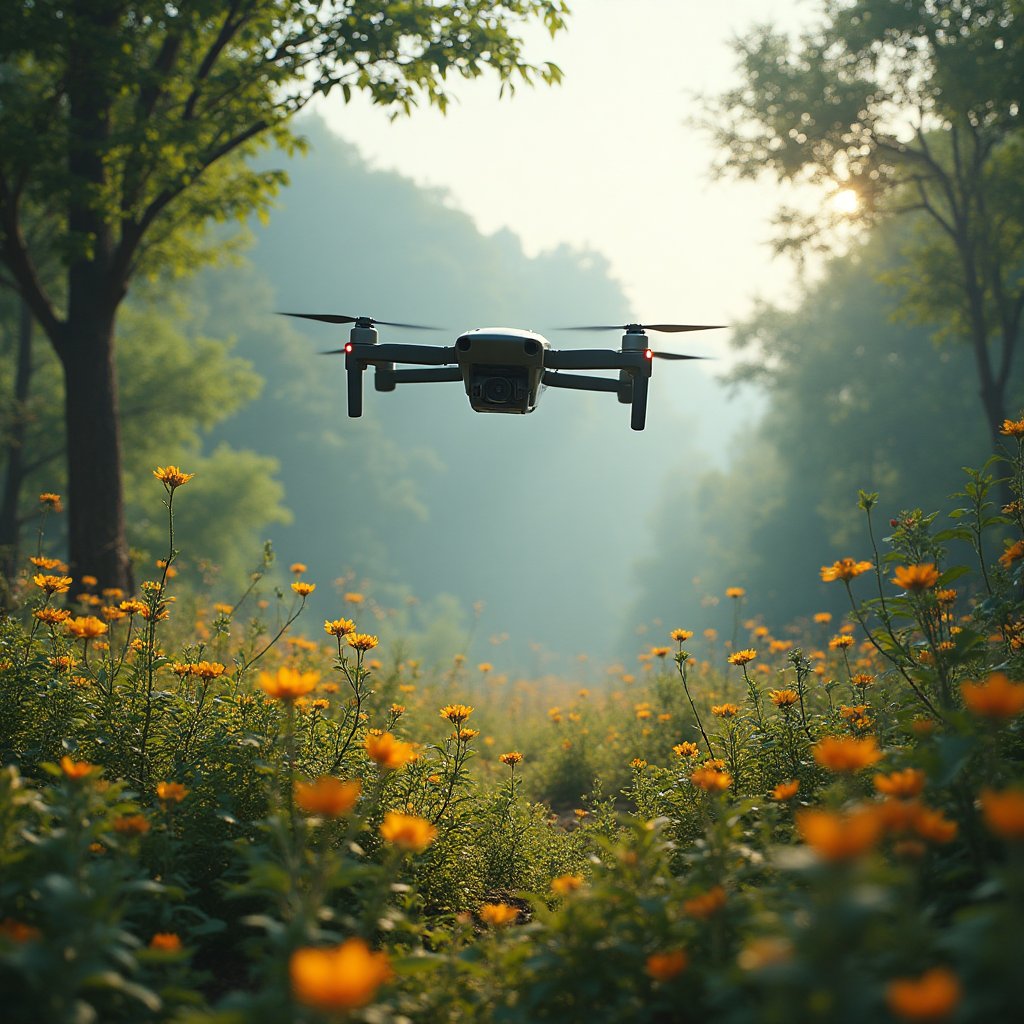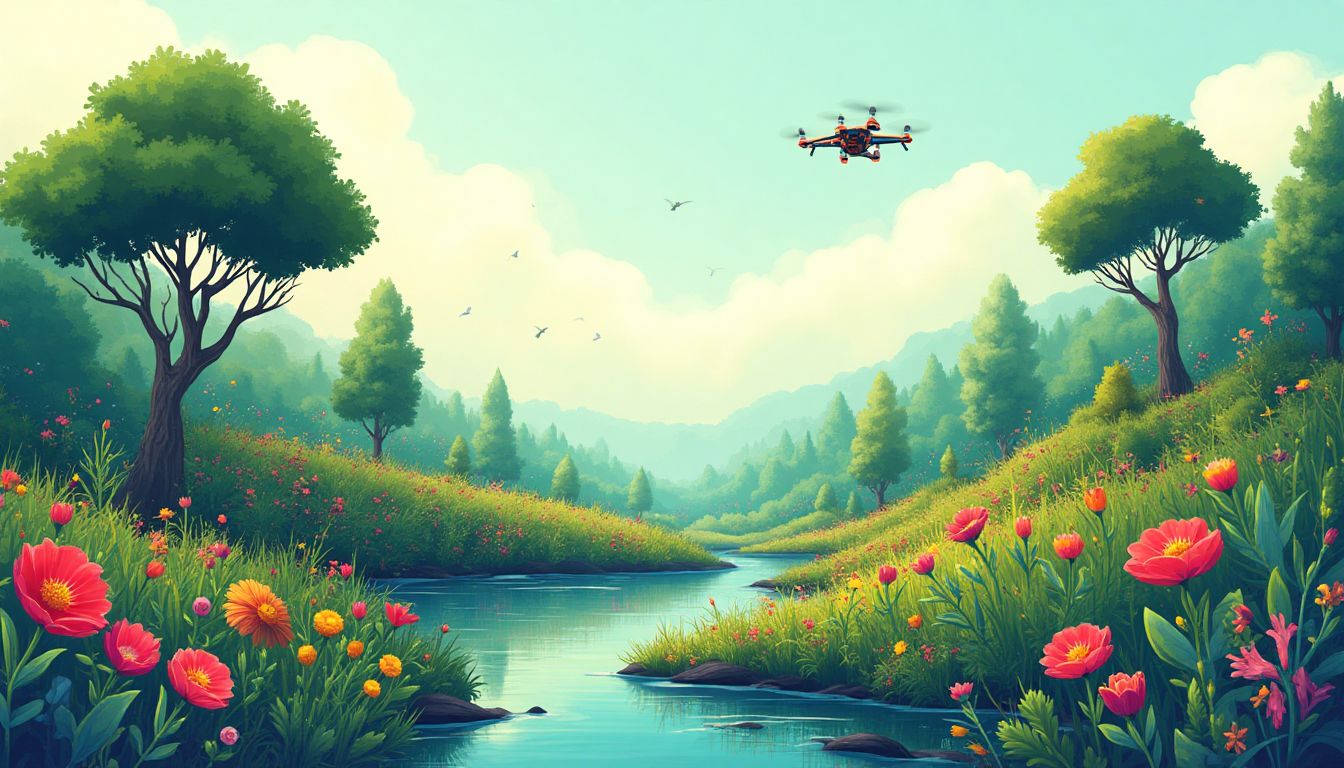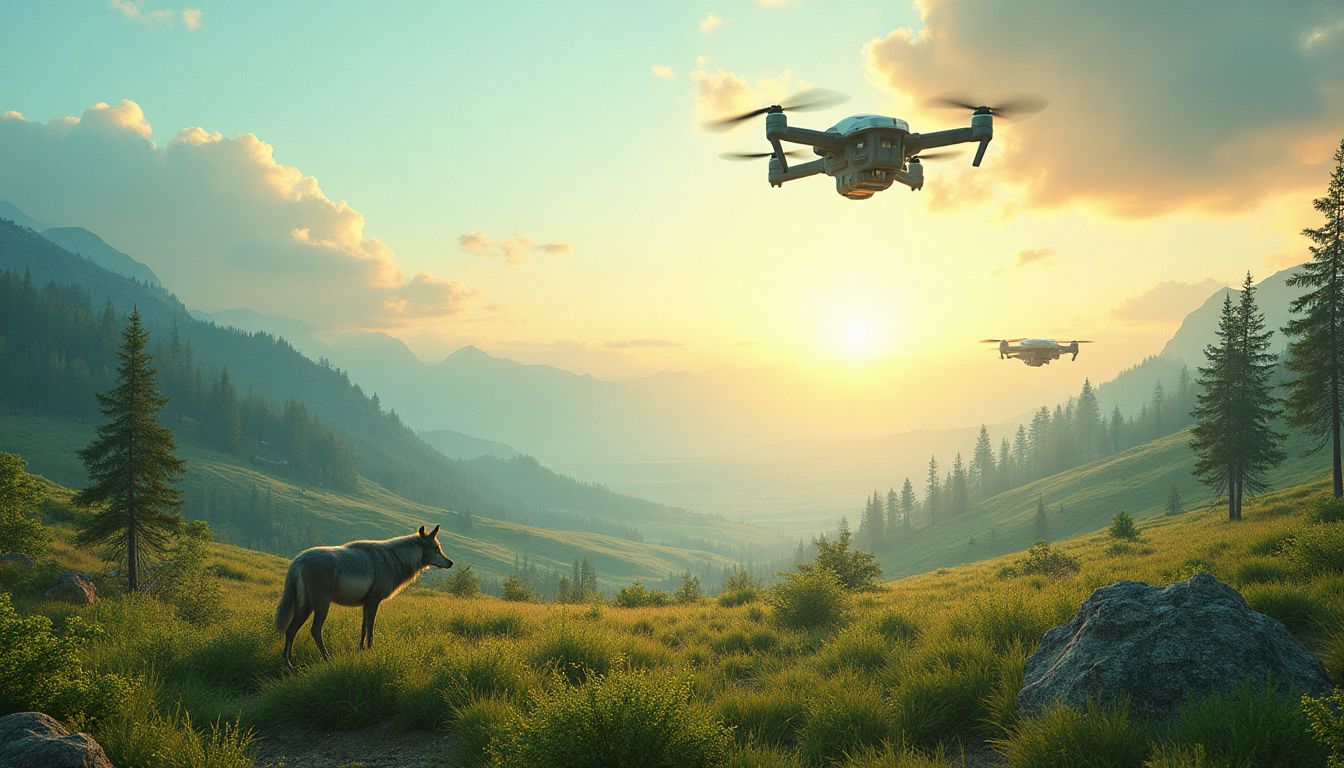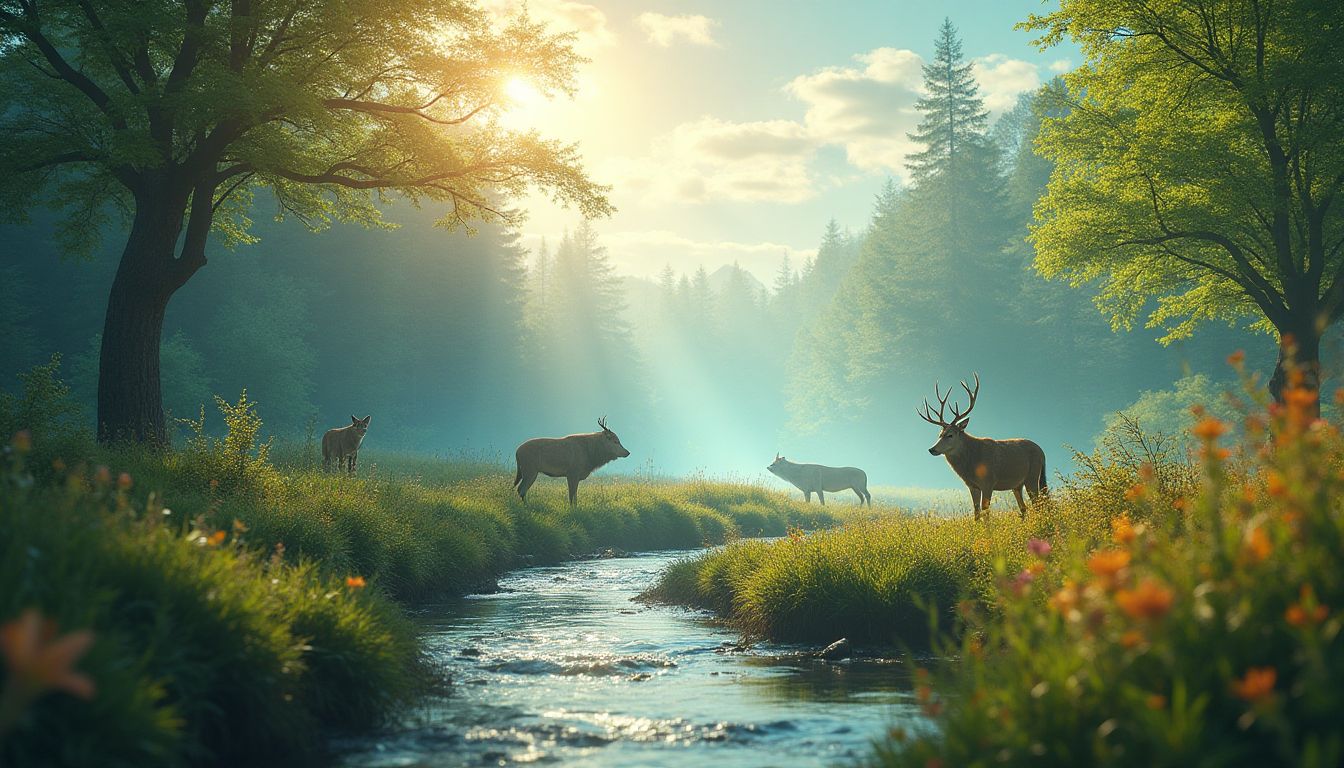Introduction: The Future of Ecosystem Restoration
The greatest threat to our planet is the belief that someone else will save it. – Robert Swan
These words sound a clarion call to action, urging us to take responsibility for our planet's well-being rather than waiting for a savior. In a world teetering on the edge of environmental calamity, collective action is our only way forward. The solutions to our most pressing ecological challenges lie not only in human hands but also in the innovative algorithms coded into today's and even tomorrow's artificial intelligence systems.
Is it possible for machines to mend the broken chords of Mother Nature's symphony? Some might chuckle at the idea that computers can do more than play chess or curate our music playlists. However, the idea of AI-powered solutions to reintroduce species and rejuvenate ecosystems is not far-fetched, but a delicious irony of using man's technological triumphs to save what humanity itself endangered.
Let's unravel this fascinating story of 'Intelligent Rewilding', where data-driven decisions meet the wilderness. We will venture into a revolutionary realm where technology meets ecology, guided by pioneers like E. O. Wilson, who envisioned a web of life connected by more than just biology, and George Monbiot, who challenged us to rewild our imaginations.
In the chapters of human history, many have sought solutions to environmental degradation. However, Stephen Hawking aptly hinted at the dual role of technology as both a destroyer and a potential savior. Bulging with promise, AI could be that savior. Join us as we embark on a journey blending creativity, science, and technology to give Earth its orchestra back.
The Role of AI in Ecosystem Restoration
Artificial intelligence is like that genius friend who not only calculates their way out of a maze but also writes a song about the journey. But how exactly does this genius contribute to saving our planet? To start, AI systems excel at processing vast amounts of ecological data, drawing patterns and insights that would take us mere mortals ages to decipher.
AI-Powered Data Analysis
Consider a scenario where AI acts as a detective, scrutinizing every leaf and twig in the forest to identify who or what has upset the ecosystem's balance. By digging into historical data and current conditions, AI can spotlight areas of distress long before they become evident to the naked eye. Imagine AI as an eco-doctor, diagnosing the planet's ailments and prescribing the right cure.
AI is already at work in various corners of the world. For instance, researchers at Stanford University are developing algorithms that scan satellite images to track deforestation trends, empowering us to implement forest management strategies more effectively.
Predictive Modeling
With new and ever-evolving threats, AI's prowess doesn't stop at identification. The real magic happens when these systems engage in predictive modeling, simulating numerous what-if scenarios of ecosystem recovery. Does releasing a pack of wolves into a forest help or hinder? AI's crystal ball—backed by data and statistics—projects possible outcomes before human efforts take root.
Consider AI a benevolent fortune-teller. It forecasts droughts, projects species population dynamics, and reveals which ecological interventions will yield the best results. The duty now lies in us to leverage these machine-born insights for real-world impact.
Case Studies in Intelligent Rewilding
Let's dive into some real-world examples where AI and ecosystem restoration have forged an alliance. If this sounds like a plot twist in an IMDb blockbuster, that's because it is. Technology is the new superhero, working behind the scenes like a less glamorous but equally crucial sidekick. From wolves rekindling drama in Yellowstone like a high-stakes family reunion to drones buzzing over the Serengeti like tech-savvy bird-watchers, these case studies will reveal how AI is changing the rules of the wild.
The Yellowstone Wolf Reintroduction
Picture this: Yellowstone National Park faced an ecological symphony out of tune. Enter the wolf, reintroduced in 1995 with a little help from AI to ensure this delicate dance went off without a hitch. Tracking the complex relationships in the ecosystem, AI tools provided insights into predator-prey dynamics that were nothing short of drama worthy of Shakespeare. As nature played catch-up, Yellowstone valleys transformed, rivers meandered differently, and plant life flourished—like a fairy godmother waving a wand. Wolves, it turns out, are the underrated protagonists in the tale of ecological balance.
The Serengeti Ecosystem Project
In Africa’s Serengeti, a technological odyssey unfolded with drones and AI steering the journey. These high-tech minions scanned the skies and land, monitoring species numbers with the precision akin to counting popcorn kernels at a movie theatre. With real-time data, conservationists could act swiftly, turning technology into an ally against poachers and a watchdog for species recovery. This high-stakes operation is no less thrilling than an epic adventure film. And in the end, wildlife populations got their shot at a sequel, one where biodiversity thrives amidst the chaos of life.
Ethical Considerations and Challenges
Of course, with great power comes great responsibility—and great questions too. As we tiptoe into nature’s domain armed with silicon chips and algorithms, we must ponder our impact. What happens when technology becomes the artist holding the paintbrush, painting vibrant colors on nature’s canvas? How long before we run the risk of playing god in ecosystems, directing the flow like a maestro in a symphony?
Biodiversity vs. Technological Interventions
Reality check: AI's help is crucial, but over-relying on it is like putting all eggs in one mechanical basket. What if algorithms make calls about which species get a second chance or pack their bags? Nature enthusiasts fret over these tech-driven decisions, fearing the loss of nature's intricate spontaneity. It's a tightrope walk, balancing between nurturing diversity and letting machines call the shots.
The Anthropocene Dilemma
We’re in the Anthropocene, a brave new era where humans hold such sway over nature. But with AI steering the ship, is our role evolving from mere passengers to active helmsmen? We must question: Are we the caretakers or the interlopers in Mother Nature's garden?
Collaboration Among Stakeholders
In the realm of ecosystem restoration, technology alone isn't enough. We need diverse voices to chime in, bringing with them different perspectives and expertise. This is where the power of collaboration comes into play, requiring interdisciplinary synergy among technologists, ecologists, policymakers, and local communities.
Building Effective Partnerships
Tech companies and environmental organizations are joining forces to formulate powerful alliances. Picture a meeting room bustling with excitement and ideas; in that room, tech geeks and tree huggers share a common goal. Both sectors recognize that their combined strengths can yield innovative conservation solutions.
- Technology provides the analytical power and scalability.
- Environmental organizations offer the ecological significance and field knowledge.
As an example, the Google Sustainability Initiative collaborates with nonprofit Rainforest Trust to map endangered ecosystems using AI algorithms. This alliance demonstrates that effective partnerships can create a blueprint for large-scale conservation success.
Community Involvement
While technology is a mighty sword, it must wield local wisdom to strike accurately. Local communities are the true custodians of ecosystems, harboring indispensable traditional knowledge. Their participation in rewilding initiatives is vital for success.
Take, for instance, the Maasai people of Kenya. When projects like those in the Serengeti involve their insights on migratory patterns, the results are significantly more effective. Similarly, through eco-friendly employment opportunities and decision-making roles, locals become stewards of change, safeguarding their heritage.
Future Trends in Intelligent Rewilding
The horizons of ecosystem restoration are brimming with possibilities. As we gaze toward the future, numerous cutting-edge technologies promise to make intelligent rewilding more effective and impactful. These advancements go beyond drones and sensors, harnessing the power of genetic engineering, cloud computing, and citizen science.
Technologies on the Horizon
New-age tools like (CRISPR) offer remarkable potential for species preservation and genetic rescue. Imagine editing genes to enhance climate resilience or cure fatal diseases in keystone species. Such innovations could redefine possibilities, allowing conservationists to adapt with precision.
Similarly, cloud computing platforms provide seamless data storage and processing, enabling ecologists to access real-time information effortlessly. Integrated data from various sources like satellites and sensors offer comprehensive insights into ecological health.
The Role of Citizen Scientists
With technology democratizing data collection, the era of citizen scientists has dawned. Imagine a world where anyone can contribute to rewilding with a simple app or via social media. Engaging laypeople in data collection not only accelerates research but fosters a shared sense of responsibility.
For instance, the iNaturalist platform invites everyday naturalists to document plant and animal sightings, curating a global repository of observations. Such platforms harness collective effort for monitoring ecosystems, embodying a flourishing trend in conservation, where participation is power.
AI Solutions: How Would AI Tackle This Issue?
Artificial Intelligence stands at the forefront of ecosystem restoration, offering a systematic approach to addressing biodiversity loss through data-driven assessments and practical applications. By employing powerful algorithms, machine learning, and automation, we can seamlessly integrate AI into rewilding initiatives. Here’s a step-by-step guide to creating a more sustainable and effective rewilding project.
Data Collection and Processing
The first step is gathering data. AI tools can utilize satellite imagery, environmental sensors, and citizen-collected data to create a comprehensive overview of targeted ecosystems. By employing platforms such as NASA's Earth observation technologies, we can track changes in land use, vegetation health, and species distribution. AI algorithms can then process this data to identify suitable habitats, enabling scientists to pinpoint areas for species reintroduction.
Automated Monitoring Systems
Once species have been reintroduced, continuous monitoring is essential to assess the success of the rewilding initiative. AI-powered drones, like those developed by DJI, can be deployed for environmental surveillance, allowing for real-time tracking of animal behavior and ecosystem health. These drones can collect data on wildlife populations, plant health, and signs of ecosystem recovery, providing valuable insights for conservationists.
Adaptive Management Strategies
Finally, AI allows for adaptive management of rewilding projects. Based on the continuous flow of data collected by monitoring systems, machine learning models can refine ecological strategies. For example, if AI detects signs of stress in a reintroduced species, it can recommend targeted interventions, such as supplemental feeding or habitat modification, to enhance survival rates. This adaptive approach promotes resilience and flexibility, ensuring projects adjust to ever-changing environmental conditions.
Conclusion: The Path Forward
The future of ecosystem restoration is an exciting crossroads where technology meets nature, and intelligent rewilding represents the cutting edge of this movement. By harnessing the power of artificial intelligence, we can revive ecosystems that have been battered by human activity, climate change, and habitat loss. As we explore these innovative strategies and embrace the potential of AI, we must also remain mindful of the ethical aspects, ensuring we use technology in a way that respects and nurtures natural processes.
There’s an inherent beauty in rewilding—it's not just about restoring what was lost, but about creating a harmonious partnership with nature and a more sustainable future for generations to come. As we take these bold steps to integrate AI into our conservation efforts, we are not merely acting as stewards of the land; we are reimagining our role as active participants and guardians of our planet. Together, let's embark on this transformative journey to forge a new alliance between humanity and the ecosystems we depend on. The time to act is now, and with the right tools and strategies, we have the ability to turn the tide on biodiversity loss and usher in a thriving, resilient world.
Action Schedule/Roadmap
Day 1: Project Kickoff
Assemble a multi-disciplinary team consisting of ecologists, AI specialists, data scientists, conservation managers, and local community leaders. Collaboration is critical from the beginning; each discipline brings unique insights vital for the project’s success.
Day 2: Initial Data Collection
Utilize drones and ground sensors from partners like Parrot Drones for collecting baseline ecological data. Gather information on flora, fauna, and soil health. Tap into crowd-sourced data from local citizen scientists through platforms like iNaturalist.
Day 3: Preliminary Analysis
Use AI-driven analytics tools to identify key species for reintroduction by assessing the existing ecological state, habitat availability, and historical species data.
Week 1: Develop Predictive Models
Employ advanced machine learning algorithms to create models forecasting ecological outcomes under various rewilding scenarios. Use platforms such as RapidMiner to automate simulations.
Week 2: Community Engagement
Initiate community meetings to foster local involvement, understand traditional ecological knowledge, and gain support for the project. Encourage participants to share their insights about historical ecosystem dynamics.
Week 3: Strategy Refinement
Refine rewilding plans utilizing feedback from community inputs and predictive modeling. Develop a clear timeline and specific goals for species introductions.
Month 1: Assembling Resources
Secure necessary resources for species reintroduction, including transportation logistics and veterinary care for the animals. Collaborate with institutions like the World Wildlife Fund (WWF) to ensure best practices are followed.
Month 2: Begin Species Reintroduction
Implement the initial reintroduction of target species, closely monitoring their acclimatization and early interactions with the habitat.
Month 3: Monitoring Phase
Deploy AI-powered monitoring systems to track the success rates and health status of reintroduced species. Integrate data dashboards using tools like Tableau for real-time tracking and updates.
Year 1: Evaluate and Adjust
Perform a thorough evaluation of project success. Adjust strategies in collaboration with experts based on data feedback and ecological assessments.
Year 1.5: Expand Rewilding Efforts
Based on initial successful outcomes, begin planning for expansions into neighboring ecosystems. Use lessons learned to enhance methodologies and stakeholder engagement.
Year 2: Full Operational Status
Achieve a stable ecosystem that supports a balanced population of reintroduced species, monitored using AI systems. This is the ideal moment to assess the overall ecological health and viability of the areas and consider additional projects.
FAQ
What is Intelligent Rewilding?
Intelligent Rewilding is a creative and smart approach to restoring ecosystems. It uses artificial intelligence (AI) and other tech tools. These help in bringing back lost species and making our environments healthy again. Imagine it as a team of scientists and tech whizzes working together to heal nature!
How can AI help in ecosystem restoration?
AI can help in many ways! Here are a few of the key tasks AI can do:
- Analyze data to identify problems in ecosystems.
- Predict how ecosystems will change based on different actions.
- Monitor habitats using drones and sensors.
- Adjust strategies based on real-time information.
With these tools, people can make better decisions about how to protect and restore our wildlife and plants.
Are there ethical concerns with using AI in rewilding?
Yes, there are some important questions we should think about:
- Over-reliance on Tech: Is it good to trust technology too much when making decisions about nature?
- Disrupting Nature: Could using AI unintentionally harm some species or ecosystems?
- The Anthropocene Dilemma: As we become more involved in nature, are we still respecting it or trying to control it too much?
These questions are tricky but important, and they help us think about our role in the environment.
What are the future trends in rewilding?
Future trends will likely include exciting advancements in technology and community involvement:
- Genetic Engineering: Techniques like CRISPR could help preserve endangered species.
- Citizen Science: More everyday people will help by collecting data about wildlife and communities.
- Improved Monitoring: Drones and sensors will become even more efficient for tracking populations and conditions.
These trends show that technology and community efforts will combine to protect and restore our ecosystems!
Can I get involved in rewilding projects?
Absolutely! Here are some great ways to get involved:
- Join local conservation groups or community initiatives.
- Participate in citizen science projects, like tracking wildlife or participating in clean-ups.
- Learn about your local ecosystem and advocate for its protection.
Even small actions can make a big difference! Every bit of help counts toward restoring our beautiful planet.
What are some successful examples of intelligent rewilding?
Here are a couple of standout examples:
- Yellowstone National Park: When wolves were reintroduced, they helped balance the ecosystem by controlling deer populations.
- Serengeti Ecosystem: In this park, researchers used drones and AI to monitor wildlife recovery effectively.
These examples inspire future rewilding efforts, showing how technology and nature can work in harmony!
Wait! There's more...check out our gripping short story that continues the journey: The Keeper of the Past
Disclaimer: This article may contain affiliate links. If you click on these links and make a purchase, we may receive a commission at no additional cost to you. Our recommendations and reviews are always independent and objective, aiming to provide you with the best information and resources.
Get Exclusive Stories, Photos, Art & Offers - Subscribe Today!





























Post Comment
You must be logged in to post a comment.